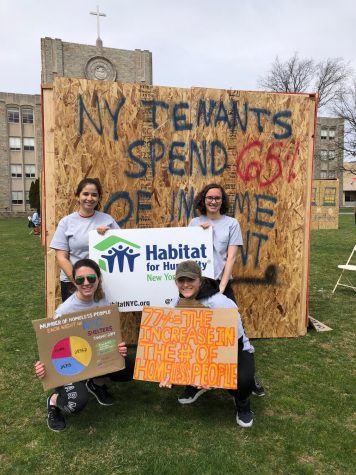
Picture an eight-by-eight-foot wooden shack, scantily put together with a hammer, a saw and some nails. There are cracks in between each wooden panel where light pours through, but it has no windows, only a single doorway. There is just barely enough room to move, let alone lay down.
Now picture living in one.
This is exactly what St. John’s University’s Habitat for Humanity chapter wanted students to imagine last week during their fifth annual Shack-a-Thon event.
The three-day advocacy event took place on the Great Lawn on April 17-19, with the participation of 11 sororities and fraternities on campus. The event is meant to raise awareness for the issue of affordable housing and housing instability.
The shacks are meant to represent houses, and as students build them on the second day of the event, they get a firsthand experience as to what it may be like for people who actually have to live in such vulnerable circumstances. The shacks are put on display on the Great Lawn so that passerby are confronted by the image of these tiny shanties meant to be lived in.
The organizations are free to decorate their “homes” however they want, but one of the three walls of each shack must include an affordable housing fact. Delta Phi Epsilon’s shack may have been adorned with flowers, but on the opposite side a shocking fact read: “Total number of people in municipal shelters: 63,025.”
Other affordable housing facts included “NY Tenants spend 65-percent of income on rent” and one shack featured a pie chart detailing the number of homeless single adults and children in shelters in New York City every night.
The facts on the sides of these shacks did not shock New York City native Khrist Sokoli, but he could see why they would come as a surprise to some.
“I think some people will be [shocked], but I’m from New York City, so I’ve seen the city change a lot from when I was maybe twelve, thirteen to now. I think that’s thanks to a lot of people’s efforts, but regardless of that there’s still work to be done,” Sokoli, a member of Phi Delta Chi fraternity, said.
“When you’re building the shacks, you’re right in the middle of the Great Lawn while everyone’s commuting from their dorms, from the classrooms or the parking lot. Everyone’s looking at you and probably thinking, ‘what is going on?’” Sokoli continued.
“By the time you’re done decorating, everyone can read the quote for Habitat for Humanity that’s been painted on and realize what these are for. It attracts a lot of attention,” he said.
While the event focuses on advocacy, a good amount of money is also raised each year and this money goes directly toward buying supplies, houses from foreclosure and setting up families so they can just live comfortably.
“We raised about $2,000 this year just through this event alone, which makes us the largest fundraiser in New York State for Habitat for Humanity,” Kayla Soulias, secretary of the SJU Habitat for Humanity chapter said. “Every year it grows and gets better.”
Housing instability comes in many forms, including frequent moves, overcrowding and the threat of eviction or the inability to find housing resulting in homelessness. This is a prominent issue in New York City and most urban centers, due to rising housing costs and an increasing population.
“I think that affordable housing is something that is not really talked about,” chapter President Gianna Bologna said. “I think we talk a lot about homelessness, we don’t necessarily think about … [how] a lot of people that are homeless are homeless because they couldn’t afford rent or couldn’t afford to pay a mortgage or something like that. A lot of those people are families or children.”
This is an issue that some students may feel detached from, however, according to Habitat for Humanity, almost half of all adults in America will be touched by housing insecurity in their lifetime.
“You assume that anybody that’s working a full time job, or two full time jobs, can afford to live. But especially in New York City, even across the country, no matter where you go, you can’t work a minimum wage job and support yourself, nevermind a family,” Bologna said.
“It’s not that they’re not trying to better themselves or that they’re trying to end up on the streets, but it’s just physically and logically impossible to support themselves. I think that’s most shocking to people. Most people assume that if you have a job you’ll be okay.”
Bologna has been a part of the SJU chapter since her sophomore year and is passionate about the issues that the organization strives to shed a light on.
“I’d heard about Habitat for Humanity, and when I found out we had a campus chapter, I don’t know, something just drew me into it,” Bologna said.
“My parents also both grew up in really, really severe poverty. My mom bounced around from apartment to apartment, and they were never homeless but they were very close to it. She always talked about the effects it had on her – she never had a consistent school she went to, a lot of times she didn’t even have a bedroom to sleep in,” she said. “The effects of bouncing and bouncing and always having to adjust, I think that’s a big part of it.”
Besides this annual event, the SJU chapter of Habitat performs a variety of service activities geared toward housing issues. This includes going to building sites, where students get a hands-on experience in building homes from the ground up side-by-side with the family that will be living in the house.
“I just think it’s nice to have everyone come together and work on something for a good cause. It brings awareness to problems that some people might not be exposed to. If someone came here from out of the state, they might not know about these issues that some New Yorkers face,” Melissa Marietto, a member of Lambda Kappa Sigma, said.
“Last year it was raining, so building and breaking down when it was raining, you realize people sometimes don’t have a way to get out of the rain and they’re stuck outside,” Soulias said. “For a lot of the Greek organizations, they have to be there, because it’s an accreditation event, so they have to be there out in the rain, building stuff. It makes you realize some people actually have to live outside in the rain.”
Rain or shine, Shack-a-Thon is the organization’s biggest event of the school year, and has developed tremendously over the five years that it has taken place on campus. Each year collaborations with other organizations increase, including this year’s collaboration with the Resident Student Association on the second day of the event to set up an inflatable obstacle course on the Great Lawn with music and food from Qdoba. These additions attract the entire student body and not just the Greek organizations that are co-sponsoring the event.
“I’m gonna be sore for a week from building these houses,” Soulias said. “But the fact that everyone will be able to realize that this is an issue makes it worth it.”









